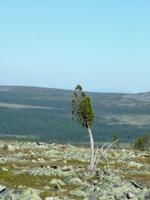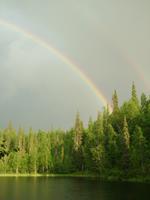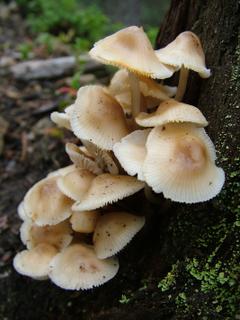Wednesday, August 31, 2005
Poronjäkälää Nuorttitunturissa - Cladonia lichen in Nuorttitunturi fell
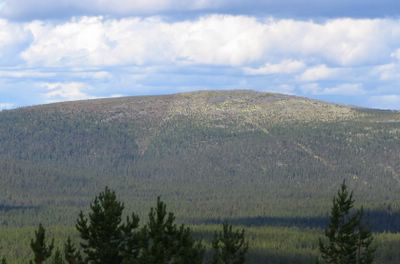
Nuorttitunturin poronjäkälävyöhyke (ks. luontopäiväkirjan merkintä 3.7.2005) kuvautuu parhaiten Pulkkatunturin pohjoisrinteeltä. Tunturin vasen laita on (ulommaisen) poroaidan laidunnetulla länsipuolella. Poroaita laskeutuu laelta alaviistoon vasemmalle, ensin koivu- ja sitten mäntyvyöhykkeeseen. Poroaidan itäpuolinen, laiduntamaton alue näkyy kuvassa kellertävänä.
In the Nuorttitunturi fell the effect of reindeer grazing can be seen, as photographed from the northern slope of Pulkkatunturi fell. In the left part of the photo an unpenetrable reindeer fence descents as straight line from the top slightly to left, down first to birch belt and then to conifer belt. Ungrazed zone, right from the reindeer fence shows as yellow.
Tuesday, August 30, 2005
Kanalintulaskenta alkanut - Fowl observation, autumn routine
Fowl observation has been one of th early autumn routines of Varrio since year 1981. In Varrio area there are three ca. 20 kilometers long observation routes. Today Tapio Selkala walked the first route close to the station and saw two female capercaillies (Tetrao urogallus), black grouse (Tetrao tetrix) and hazel grouse (Bonasa bonasia). (PM)
Labels: koppelo, metso, pyy, teeri
Monday, August 29, 2005
Kiiltopaju ensiksi ruskaan - Salix phylicifolia turns into yellow first

Värriön pajuista ruskaan menee ensiksi kiiltopaju (Salix phylicifolia). Kyseessä ei ole kuitenkaan yöpakkanen, eikä päivän pituuden väheneminen liioin. Kiiltopaju on pajuista herkimpiä ruostesienille, niin kuin tämäkin yksilö Värriöojan varressa.
Of the willows in Varrio Salix phylicifolia turns into yellow first. This is not, however, because of the autumn frosts, or shortening of the day length. Salix phylicifolia is just most susceptible to fungi which color the leaves into yellow already in August.
Sunday, August 28, 2005
Alailmakehän otsonin korkeita pitoisuuksia - High levels of tropospheric ozone
Alailmakehän otsonin muodostumiseen liittyy läheisesti typen oksidien kohonneet pitoisuudet. NO2 hajoaa auringonvalon vaikutuksesta typpimoksidiksi ja happiradikaaliksi. Vapaa happiradikaali liittyy happeen O2 ja syntyy otsonia O3. Kun taas otsoni ja typpimonoksidi kohtaavat, ne reagoivat muodostaen happea ja typpidioksidia. Hapettaessaan saasteita alailmakehän otsoni muuttaa ne helpommin ilmakehästä poistuvaan muotoon ja puhdistaa siten ilmaa.
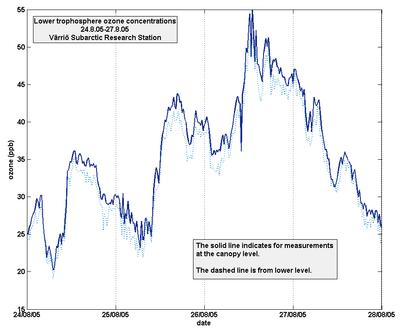
Last few days at SMEAR-station we have measured quite high concentrations of tropospheric ozone. Normally, the ozone level remains at Värriö subarctic research station somewhere around 20 ppb, but the day before yesterday the concentration rised up till 55 ppb. The limiting value according to EU-directives is c. 92 ppb.
High values of NOx are related to the formation of tropospheric ozone. When NO2 degrades due to the sun radiation into NO and O (oxygen radical), free oxygen radical connects to oxygen and ozone formates. When O3 and NO meet, they react forming O2 and NO2. When oxidizing pollutants and transforming them into a form which easily leaves the atmosphere, O3 cleanse the air.
(E-MK)
Mansikkapaikka Pirunkurussa - Strawberries in Devil's Creek
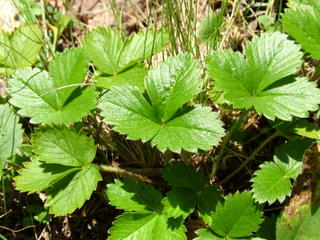 Värriön seudun kuruissa kohtaavat monet eteläiset ja pohjoiset kasvit. Ahomansikka (Fragaria vesca) kasvaa täällä levinnäisysalueensa pohjoisella äärilaidallaan. Noin 20 metriä mansikkapaikasta kasvaa varjoisessa loukossa pohjoinen pahtarikko (Saxifraga nivalis).
Värriön seudun kuruissa kohtaavat monet eteläiset ja pohjoiset kasvit. Ahomansikka (Fragaria vesca) kasvaa täällä levinnäisysalueensa pohjoisella äärilaidallaan. Noin 20 metriä mansikkapaikasta kasvaa varjoisessa loukossa pohjoinen pahtarikko (Saxifraga nivalis).Many southern and northern species grow close to each other in the creeks of Varrio nature reservat. Wild strawberry (Fragaria vesca) grows here at its most northern fringes of its distribution area. Ca. 20 meters from the strawberry place appears a northern species, Snowball saxifragae (Saxifraga nivalis). (E-MK, PM)
photo: Ella-Maria Kyrö
Saturday, August 27, 2005
Pahtarikko, varjon kasvi - Snowball saxifragae, shadows plant
 Syväkurun kellari-ilmastossa kasvaa pahtarikko (Saxifraga nivalis). Tämä tunturikasvi kasvaa havumetsävyöhykkeessä harvinaisena vain varjoisilla jyrkänteillä.
Syväkurun kellari-ilmastossa kasvaa pahtarikko (Saxifraga nivalis). Tämä tunturikasvi kasvaa havumetsävyöhykkeessä harvinaisena vain varjoisilla jyrkänteillä.At the cellar climate of Deepcreek grows Snowball saxifragae (Saxifraga nivalis). This fellspecies grows at the boreal forest region very rarely at the shadowy cliffs. (PM, E-MK)
photo: Ella-Maria Kyrö
Missä kasvaa Suomen eteläisin hapro? - Where grows Finland's most southern Mountain sorrel (Oxyria digyna)?
 Syväkurun varjoisessa rotkossa kasvaa pohjoinen tunturikasvi hapro (Oxyria digyna). Raparperin sukulaisen hapron lehdet maistuvat kirpeän raikkailta. Pohjois-Sallan kurujen lumenviipymäpaikoilla kasvaa useita pohjoisia lajeja levinneisyysalueensa eteläreunallaan. Onko Syväkurun haproesiintymä Suomen eteläisin?
Syväkurun varjoisessa rotkossa kasvaa pohjoinen tunturikasvi hapro (Oxyria digyna). Raparperin sukulaisen hapron lehdet maistuvat kirpeän raikkailta. Pohjois-Sallan kurujen lumenviipymäpaikoilla kasvaa useita pohjoisia lajeja levinneisyysalueensa eteläreunallaan. Onko Syväkurun haproesiintymä Suomen eteläisin?In the shadowy galleys of Deepcreek grows a northern fellspecies Mountain sorrel (Oxyria digyna). Mountain sorrel is relative to rhurarb and its leaves taste sour and fresh. In the creeks where snow stays long until summer grows few northern species at the southernmost boarders of their distribution area. Are these Mountain sorrels in Deepcreek the most southern in Finland? (PM, E-MK)
photo:Ella-Maria Kyrö
Friday, August 26, 2005
Varpunen, huippuharvinaisuus Värriössä - House sparrow, extremely rare bird in Värriö
(PM)
On this morning we met curious female House sparrow (Passer domesticus) exploring between kitchen and cellar. The last times when House sparrow has been seen in this region were years 1994 and 1970 close to the Ainijärvi lake. What would make this urban bird to fly to backwoods?
Katajanmarjoja - Juniper berries
 Katajan (Juniperus communis) kävyt ovat meheviä marjoja, jotka kypsyvät sinisiksi vasta kolmantena syksynä kukinnasta. Entisaikaan marjoilla uskottiin olevan maagisia parantavia vaikutuksia, nykyään niitä käytetään lähinnä mausteina.
Katajan (Juniperus communis) kävyt ovat meheviä marjoja, jotka kypsyvät sinisiksi vasta kolmantena syksynä kukinnasta. Entisaikaan marjoilla uskottiin olevan maagisia parantavia vaikutuksia, nykyään niitä käytetään lähinnä mausteina.Juniper's (Juniperus communis) seed cones are berry-like, they ripen on the third autumn after blossom. Traditionally berries were belived to have a magical healing effect, but today they are mainly used as spices.
(KL)
Photo: Katrianne Lehtipalo
Thursday, August 25, 2005
Ruohokanukka marjoo Värriössä - Cornus suecica in berries

Ruohokanukka (Cornus suecica) marjoo elokuussa Värriön kosteissa kuruissa. Se on verraten yleinen marja, mutta poiminnan kannalta arvoton.
Cornus suecica is rather common berry in Varrio, in moist creeks under spruce trees. For berry picking it is rather valueless.
Wednesday, August 24, 2005
Tuntsan suuri palo 1960 - Great Forest Fire in Tuntsa 1960
In eastern Lapland year 1960 was the second hottest in the century. That summer the biggest forest fire ever in Finland flamed in Tuntsa area. In the 1960s Kemi forest company harvested 300 000 cubic meters that were burned wood from the fire region. The fact that Tuntsa is situated 67 N and 300 meters above sea level made it difficult to regenerate the forest. Even though in the northernmost areas of the burned region at Värriö nature reserve a young Scots pine forest is growing.

Tuntsan paloaluetta Värriö V:ltä nähtynä.
Tuntsa forest fire area from Varrio fells (Varrio V).
photo: Ella-Maria Kyrö
Kiirunoita Sauoivalla - Rock ptarmigans on Sauoiva fell
(PM ja KL)
On the top of 615 m high Sauoiva fell Rock tarmigans (Lagopus mutus) are found. They are related to Willow ptarmigans (Lagopus lagopus). Rock ptarmigan's southernmost habitat is on Tuntsa and Varrio fells. In summertime Rock ptarmigan is grey while Willow ptarmigan has brown feathers.
Lounatuulen laulu - Southwest wind
A brisk wind is blowing in Varrio.
Wind velocity is measured on SMEAR-station with both rotating cup anemometres and by ultrasound. The measurements are carried out on six different heights in the weather tower (2-16m). The ultrasonic anemometer is in the left picture and a cup anemometer on the right side.
(KL)
Photos: Katrianne Lehtipalo
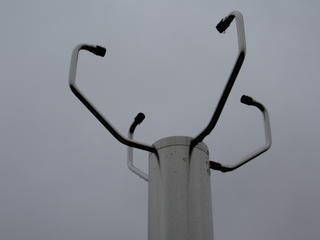
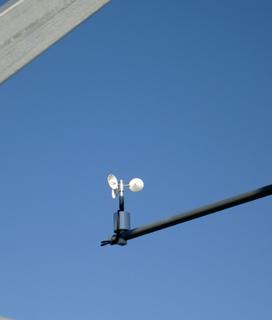
Mitä ovat pohjanrypäleet? - Arctostaphylos species in Varrio fells
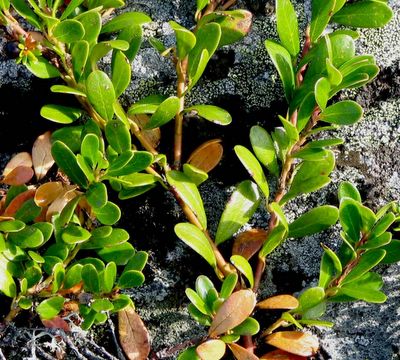
Sianpuolukat (Arctostaphylos), on kanervakasveihin (Ericaceae) kuuluva kasvisuku. Arctostaphylos -lajeja on maapallolla kaikkiaan noin 50, joista Suomessa tavataan vain kaksi: sianpuolukka (Arctostaphylos uva-ursi; kuvassa) ja riekonmarja (A. alpinus; katso luontopäiväkirjan merkintä 4.8.2005). Ne kasvavat myös Värriötuntureilla.
Suvun nimi Arctostaphylos tulee kreikan sanoista arktos (tarkoittaa karhua tai pohjoista) ja stafyle (tarkoittaa rypälettä). Arctostaphylos -lajeja voisi nimittää siten karhunrypäleiksi tai pohjanrypäleiksi. Molemmat suomalaiset lajit (sianpuolukka ja riekonmarja) ovat kuitenkin mauttomia, eikä niillä ole juuri marjastusarvoa. - Sianpuolukan marjominen 2005 näyttää Värriötuntureilla heikolta.
The genus Arctostaphylos belongs to the Heath family (Ericaceae). There are about 50 Arctostaphylos species in the world, but only two of them grow in Finland (also in Varrio nature reserve): Common bearberry (Arctostaphylos uva-ursi; in the photo) and Alpine bearberry (A. alpinus; see the nature diary note of 4.8.2005).
The genus name Arctostaphylos comes from Greek word arktos (which refers to bear or northern) and stafyle (which refers to grape or cluster). Besides the common name bearberies the Arctostaphylos species could also be called as nordic grapes. Neither of the species, however, deserves such an attractive name. They are both tasteless and they do not have real value for berry picking. Let them be bearberries.
Tuesday, August 23, 2005
Kulmajuovainen ritariyökkönen - Catócala núpta
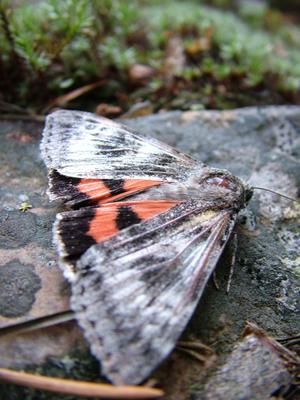
Viime yönä Värriö 1:n valorysään oli lentänyt kulmajuovainen ritariyökkönen (Catocala nupta). Laji on melko harvinainen ja yökkösistämme suurin ja kaunein.
Last night a Catocala nupta - moth had flown into a light trap at Varrio 1. The species is rather rare and the biggest and most beautiful of moths in Finland.
(EMK ja KL)
photo: Ella-Maria Kyrö
Monday, August 22, 2005
Idänkalvaspaju Värriöojan varressa - Salix hastata ssp. subintegrifolia
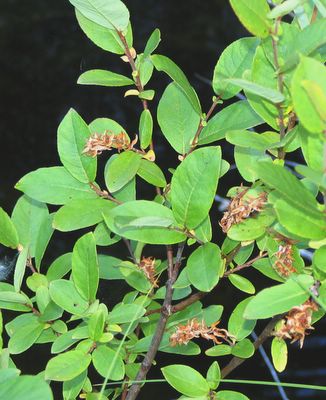
Värriöojan varressa, pitkospuureitin yläpuolella kasvaa pajupehko, joka on todennäköisesti idänkalvaspajua, Salix hastata ssp. subintegrifolia - vai onko?
This willow bush grows at a small creek of Varrio-oja, upstream near to the Varrio track. The species is apparently the eastern Salix hastata ssp. subintegrifolia - or is it?
Lapin alppikauris - The lappish ibex

Sunday, August 21, 2005
Hirvi hyppää yli poroaidan portin - Moose jumps over reindeer gate

Itärajallamme on niin Värriön luonnonpuistossa kuin muuallakin maassa noin kolmen kilometrin rajavyöhyke. Aivan valtakunnan rajan läheisyydessä on hyvässä kunnossa pidettävä poroaita, jonka jälkeen on vielä 50-100 metrin kaistale Suomen maa-aluetta, minne poroja ei päästetä. Porot pysähtyvät viimeiseen poroaitaan. Mutta hirvet eivät pysähdy. Poroaidan portit ottavat tämän huomioon. Portin ylimmän pienan korkeus pidetään aina sellaisella tasolla, että poro ei siitä kykene hyppäämään yli, mutta hirvi halutessaan kykenee - kuten tästä Kynsikurun portista lähellä Nuorttitunturia.
There is a border zone of about 3 kilometers towards the eastern border of Finland in Varrio Nature Reserve, as everywhere on the border between Finland and Russia. Just in front of the the border, 50-100 meters in the Finnish side, there is a strong reindeer fence to eliminate reindeer movements over the border. Moose, however, is so strong that the reindeer fence will not necessarily stop it, and mooses could break the fence. This problem is taken care of by the gates in the reindeer fence. The height of the gate is regulated by wooden poles so that reindeers cannot jump over thye highest pole, but the moose can if it so decides. The suitable height can be seen in the Kynsikuru gate near Nuortti fell.
Syksyn merkkejä - Autumn tokens

Loppukesä on vähitellen muuttumassa syksyksi. Värriö I:n rinteillä tunturikoivujen lehdet jo kellastuvat.
Late summer is gradually becoming autumn. Leaves on mountain birches are already turning yellow.
(KL)
Photo: Katrianne Lehtipalo
Saturday, August 20, 2005
Mistä johtuvat taivaan värit? - What creates the colours of the sky?
Sateenkaari syntyy, kun auringonsäteet taittuvat kaksi tai kolme kertaa ilmakehässä olevissa vesipisaroissa. Edellinen tuottaa vahvavärisen pääsateenkaaren, ja jälkimmäinen himmeämmän sivusateenkaaren. Valon on tultava juuri oikeasta kulmasta vesipisaroihin, jotta sateenkaari syntyisi.
The rainbow is created when light is refracted two or three times in the water droplets of atmosphere. The former produces a strong-coloured main rainbow, the latter makes an obscure subrainbow. The light has to come excactly from the right angle in order to create the rainbow.
(EMK)
Friday, August 19, 2005
Iltahämärää - Dusk
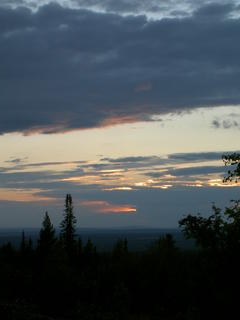
Elokuun illat hämärtyvät nopeasti. Aurinko laskee jo noin klo 21.30. Yötön yö päättyi heinäkuun puolivälissä.
Auringon lasku- ja nousuajat ilmoitetaan sen yläreunan mukaan. Hämäräksi kutsutaan aikaa laskusta/noususta siihen, että aurinko on 6 astetta horisontin alapuolella.
Nights are rapidly getting darker in August. The sun sets at about 9.30 pm. The period of midnight sun ended in mid-July. Twilight is the time from sunset/rise untill the sun is 6 degrees below horizon.
(KL)
Photo: Katrianne Lehtipalo
Thursday, August 18, 2005
Mikä on kiveliö? - Wilderness scenery from Varrio northwards
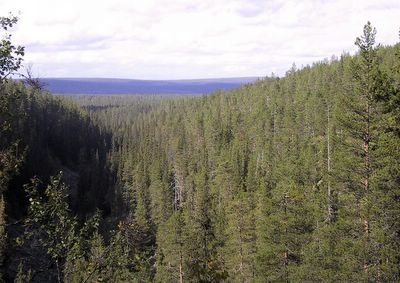
Onko tämä maisema kiveliö? Suomen kielen alkuperäissanastossa kiveliö tarkoittaa Pohjois-Suomen ja Lapin laajaa asumatonta metsämaata, sydänmaata, saloseutua, erämaata, selkosta, selkää, selännettä joka on vähän ympäristöään korkeammalla. Värriön kiveliömaisema avautuu Kotovaaran länsikylkeä kohti pohjoista.
Finnish language has a special word for a wilderness scenery like this: "kivelio"
Wednesday, August 17, 2005
Sinilevä kukkii Kuutsjärvessä - Anabaena lemmermannii in flower in Kuutsjarvi

Elokuun puolivälissä täysin puhtaaksi luultu Värriötunturin kaltiolampi - aseman rantasaunan Kuutsjärvi yllätti. Se puhkesi kellertävään kukkaan. Aiheuttajaksi paljastui Anabaena lemmermannii sinilevä. Miten ihmeessä se päätyi Värriön kiveliöön?
In mid August the Kuutsjarvi lake, that is situated just below the station, was hit by the blue algae Anabaena lemmermannii. How in the earth it chose Kuutjarvi in Varrio nature reserve, to start to blossom?
Sieniä sateella - Mushrooms in the rain
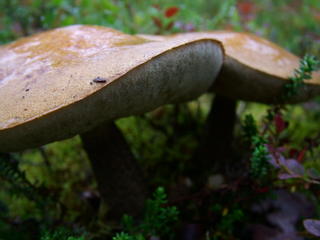
Sateinen sää on saanut sienet kasvuun Värriön luonnonpuistossa.
The rainy weather has multiplied the amount of mushrooms in Värriö.
(KL ja E-MK)
photos: Ella-Maria Kyrö
Tuesday, August 16, 2005
Koillistuuli tuo rikkidioksidia - Norhteast wind brings sulphur dioxide
Kuvassa näkyy Värriön SMEAR-asemalla mitatut rikkidioksidipitoisuudet 14.-15.8.2005. Tuulen suunta kääntyi illan aikana (14.8) lännestä koilliseen, ja samalla pitoisuudet lähtivät nousuun.
Ilmanlaatu on Värriöllä tästä huolimatta hyvä. EU:n raja-arvot rikkidioksidille ovat tunnin keskiarvona 350 ug/m3 eli noin 133 ppb, minkä alle jäädään selvästi. (KL)
 Sulphur dioxide (SO2) is a pollutant, which irritates respiratory organs and causes acid fall-out. In high concentrations it also directly affects needles and leaves in trees.
Sulphur dioxide (SO2) is a pollutant, which irritates respiratory organs and causes acid fall-out. In high concentrations it also directly affects needles and leaves in trees.
The figure depicts sulphure dioxide concentration measured in Värriö SMEAR-station 14.-15.8.2005. The wind direction changed during evening (14.8) from west to norhteast and the concentrations increased meanwhile.
The air quality in Värriö is nevertheless good. The limiting value for sulphur dioxide according EU directives is 350 ug/m3 (133ppb), much higher than the measured concentrations.
Pohjannokkonen Kuntaskurussa - Urtica dioica var. sondenii in Kuntas canyon

Pohjannokkonen (Urtica dioica var. sondenii) kasvaa Kuntaskurun vesiputouksella, pari kilometirä tukikohdasta alavirtaan. Tämä nokkonen ei polta, koska sen varsi on sileä, lähes poltinkarvaton.
Urtica dioica var. sondenii grows in Kuntas canyon, about 2 kilometers downstream from the station. This nettle does not burn.
Monday, August 15, 2005
Kuinka outamaan männikkö uudistuu - How old pine forest regenerates?

Jossakin vaiheessa (200-500 vuoden iässä) tuuli kaataa Värriön outamaassa kasvaneen ikimännyn. Tuulenkaadon alta paljastuu kivennäismaa, ja kun sattuu sopiva siemenvuosi, uusi männyn taimi pääsee kasvunsa alkuun vanhan puun paikalle. Kuvan taimi on 15-20 vuoden ikäinen.
At some point (at age of some 200-500 years) the old Scots pine trees of Varrio are fallen down by stormy wind. Mineral soil is revealed from ynder the stump. If a favorable seeding year occurs, a new seedling of Scots pine can grow exactly in the same place as the old tree. The seedling in the picture is some 15-20 years old.
Sunday, August 14, 2005
Sade putoaa Härkätunturiin - West wind rain falls in Harkatunturi fell

Elokuun länsituuli työntää sadetta Värriötuntureiden vedenjakajaharjanteelle. Ensimmäisenä sateen ottaa vastaan Härkätunturi.
Heavy August rains are coming from west. The chain of fells of Varrio is a natural divide between the rivers flowing either to west to Gulf of Bothnia and the rivers flowing to east to White Sea, or to the northeast to Arctic Ocean. Such a natural divide is apt to catch first the incoming rains, like the one falling in Harkatunturi fell.
Saturday, August 13, 2005
Kenkäheinää Puolivälinjängällä - "Shoe grass" in Puolivalinjanka

Elokuussa tasainen sarakasvusto peittää laajoja alueita Puolivälinjänkää. Onko tämä Lapin kansan taannoin nutukkaissaan käyttämää kenkäheinää?
In August an even carpet of sedges covers large areas of Puolivalinjanka (aapa mire). Is this sedge the "grass" that the Lappish people used harvest, dry and prepare for winter use in their reindeer skin shoes?
Friday, August 12, 2005
Pullosara - Bottle sedge

Kenkäheinäksi korjattiin pullosaraa (Carex rostrata). Sen tähkät ovat kuin maissin tähkät pienoiskoossa.
"Shoe grass" has been identified as bottle sedge (Carex rostrata). It has cobs like maize cobs in miniature size.
Thursday, August 11, 2005
Kapustarinta alkavassa ruskassa - Golden plover by August colors

Kapustarinta (Pluvialis apricaria) huutelee Värriötunturissa (Värriö I) surumielisen vienolla äänellään vielä elokuun alkavassa ruskassa.
European golden plover (Pluvialis apricaria) remains still behind in Varrio fells in the beginning of August, when the autumn colors start to take over.
Wednesday, August 10, 2005
Värriön keskilämpötila nousussa - Mean temperature of Varrio is rising

Värriön tutkimusasemalla on mitattu päivittäiset ilmastotunnukset jokaisena päivänä 30 kalenterivuoden ajan (1975-2004). Vuoden keskilämpötila on sinä aikana noussut 1.3 astetta. Vuosivaihtelu on silti suuri.
Daily climate data have been recorded in Varrio Subarctic Station for 30 full calendar years (1975-2004). The mean annual temperature has risen 1.3 degrees. The variation around the mean, however, is considerable.
Tuesday, August 09, 2005
Joko Värriössä on ruskan aika? - Early autumn colors in Varrio
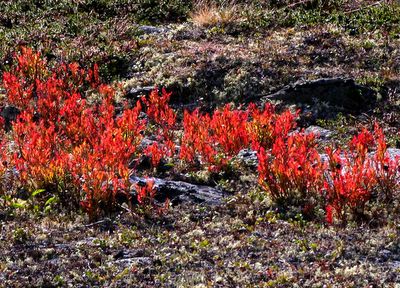
Osa Varrio I:n mustikoista on punastunut jo elokuun alussa ruskan väreihin. Kyse ei ole pakkasista; yöpakkasia ei ole vielä ollut.
Some of the bilberries (Vaccinium myrtillus) in Varrio I, have already turned into autumn red, surprisingly early as it is the 9th of August. The red color is not a result of frost, as there has not yet been any night frost in the fell.
Maakotka Rakitsan vaarassa - Golden eagle above Rakitsa hill
Golden eagle (Aquila chrysaetos) flew over Rakitsa hill at noon and continued towards Sauoiva fell. The population of Golden eagles is rather stabile in Eastern Lapland. For some reason it is not nesting in Varrio nature reserve, and neither is often seen in the sky.
Monday, August 08, 2005
Metsälauhaa poroille - Wavy hair-grass for reindeers

Värriössä ja koko Itä-Lapissakin yleinen metsälauha (Deschampsia flexuosa) on poron tärkeimpiä laidunkasveja. Etenkin vasomisaikaan metsälauhan maittavuus poroille menee kaikkien muiden kasvien edelle.
Wavy hair-grass (Deschampsia flexuosa) is one of the most common grasses in Varrio nature reserve and in whole East Lapland. This grass is palatable to reindeers and highly preferred especiaqlly during the calving season.
Värriön keräkurmitsoilla hyvä vuosi - Dotterels had a good year in Varrio

Värriötuntureiden keräkurmitsat laskettiin heinäkuun alussa (katso Luontopäiväkirjan merkintä 2.7.2005). Viime vuoden taantuman jälkeen keräkurmitsoilla oli hyvä vuosi. Värriön keräkurmitsat on nyt laskettu 11 kertaa samanlaisella linjamenetelmällä vuosina 1990-2005. Tuntureiden kokonaiskanta on pysynyt lähes vakaana, noin 12 havaitussa linnussa.
Katso lisää aiheesta: Laurila, J. 2005. Värriön keräkurmitsoilla hyvä vuosi. Suomen Luonto 8/2005 (64): 12-13.
The dotterels (Charadrius morinellus) of Varrio fells were counted on 2 July 2005 by walking in line through the regio alpina, 11 km southwards at western side and 11 km northwards at eastern side of the fells ("the annual dotterel walk"). After poorer year of 2004 the dotterels had a good year in 2005. All in all the population has remained quite stabile, at about 12 counted birds, over the sampled period of 1990 - 2005. The Varrio dotterels have been described more in the August issue of the Finnish Nature magazoine (Suomen Luonto 8/2005, pp. 12-13.)
Sunday, August 07, 2005
Harmaasara elokuun illassa - White sedge in August night
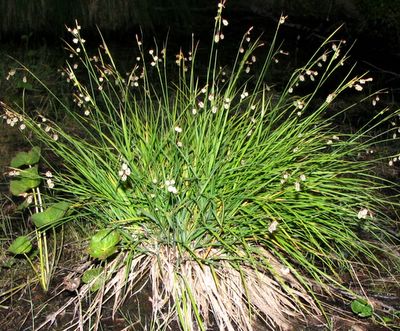
Elokuun hämärtyvässä illassa tiheään mätästävän harmaasaran (Carex canescens) valokuvaus onnistuu parhaiten salamavalolla. Kuva Värriön pitkospuureitiltä Jyppyrävaaran eteläpuolelta.
In the darkening night of August photographing of White sedge (Carex canescens) is best done with flash. This specimen grows at Varrio track, near to the station.
Tutkimusasema aamusumussa - Research Station in morning fog
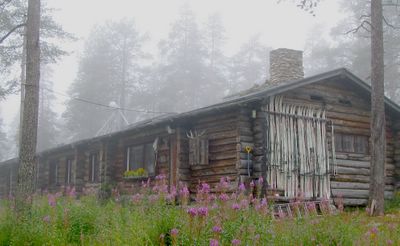
Värriön tutkimusasema heräsi elokuisen sunnuntain aamuna sankkaan aamusumuun. Sääasema näytti ilman suhteelliseksi kosteudeksi 99 prosenttia ja lämpötilaksi 8.1 astetta. Aamusumu on yhteydessä edelliseen päivän havaintoon: koko lauantain ilma oli ajoittaisesta auringonpaisteesta ja kohtalaisesta tuulesta huolimatta niin kosteaa, että niin outamaan kuin tunturinkin varvikko pisaroi vettä koko päivän - kastellen kulkijan maastokengät litimäriksi.
Värriö station woke up in the morning of August Sunday in the middle of thick morning fog. The climate station showed figures for relative humidity and temperature 99 per cent and 8.1 degrees, respectively. The morning fog is related to the moist weather of the previous day. Despite of sunshine and moderate wind, the higland air was so moist that the grasses and herbs of forests and fells kept wet the whole day - wetting also the shoes of the hiker.
Saturday, August 06, 2005
Sinisuohaukka Pulkkatunturissa - Hen harrier in Pulkkatunturi
Hen harrier (Circus cyaneus), female, was seen in flying from north to south along the western edge of Pulkkatunturi ("Pulkkafell"), in moderate mid day west wind. Seeing Hen harrier in Varrio nature reserve is always a case, as it is rather rare in whole eastern Lapland. Hen harrier is more typical in western Lapland and in lowlands of the coastal zone of Gulf of Bothnia.
Karhu tappoi hirven ja vasan Nuorttitunturissa - Brown bear killed moose in Nuortti fell
While radiotracking capercaillies Tarmo Kylli, one of Varrio staff members, found remnants of female moose (Alces alces) and calf on the foothill of Nuorttitunturi ("Nuortti fell"). Based on the signs in the remnants and on the surroundings (for instance large stones were turned over) he concluded that brown bear had managed to kill both a small sized female and her calf. The remnants were less than one month old.
Lämpötilan mittausta monella tavalla - Measuring temperature in many ways

Aseman pihassa lämpömittarit luetaan manuaalisesti kaksi kertaa päivässä. Lämpötilatiedot siirtyvät myös automaattisesti Ilmatieteen Laitokselle.
The thermometers in the yard are read manually twice a day. Temperature data is also automaticly transfered to Finnish Meteorological Institute.
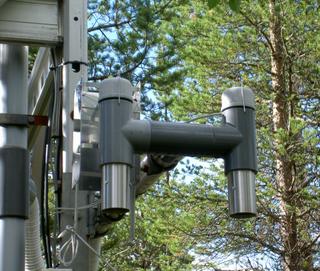
SMEAR-aseman säätornissa lämpötilaa mitataan jatkuvasti viideltä eri korkeudelta (2m, 4m, 6.6m, 9m ja 15m) .
On SMEAR station temperature is measured continuously from five different hights in the weather tower (2m, 4m, 6.6m, 9m and 15m).

Värriö I:n huipulla tunturipiirturi tallentaa lämpötilakäyrän.
On the top of Värriö I fell, a plotter records the temperature curve.
(KL)
Photos: Katrianne Lehtipalo
Friday, August 05, 2005
Valorysä Värriö I:llä - Light trap in Varrio I

Elokuun illan jo hämärtyessä valorysät pyydystävät tunturin hyönteisiä paremmin kuin juhannuskesällä. Kyseessä on pitkäaikainen yhteistutkimus Oulun yliopiston eläinmuseon intendentti Juhani Itämiehen kanssa.
In the gradually darkening nights of August the light traps start to catch insects better than in mid-summer. The traps belong to long-lasting joint research with Dr. Juhani Itamies, curator of the Zoological museum of University of Oulu.
Thursday, August 04, 2005
Riekonmarja marjoo jo - Alpine bearberry is maturing

Riekonmarja (Arctostaphylos alpinus) tekee jo marjaa Värriön outamaassa.
Alpine bearberry (Arctostaphylos alpinus) has already berries in the forest zone Varrio nature reserve. Bearberries are believed to be foodstuff of bears - the Finnish name refers to willow ptarmigans (Lagopus lagopus)
Wednesday, August 03, 2005
Elämänlanka erämaasta - Link from the wilderness

Vaikka Värriön luonnonpuisto on eräs syrjäisimpiä ja erämaisimpia kolkkia Suomessa, yhteydet rintamaille hoituvat Värriötunturin (Värriö I) laelle pystytetyn puhelin- ja tietoliikennemaston kautta. Myös Värriön SMEAR I -ilmastoaseman mittaustiedot siirtyvät automaattisesti tämän linkkimaston kautta Helsingin yliopiston keskustietokoneisiin. Linkkimastoon johtavasta sähkölinjasta saadaan virtaa muun muassa hyönteisiä pyytäville valorysille (kuvan alalaidan valkea piste, sähköpylväiden välissä).
Although Varrio nature rerserve is one of the most remote and most wilderness-like corners in Finland, the connections to the outside world are excellent. Radio link (tower) has been erected on top of Varrio I for mobile phone and data transfer traffic. The massive data generated by the SMEAR I -station are transmitted automatically through this link tower from Kotovaara to University of Helsinki computers. The power line to the link tower supplies electricity also to various research equipments, like for instance for the light insect traps (see the white spot at the bottom of the photo, between the transmission line poles).
PAR-säteilystä - Photosynthetically active radiation
Käyristä näkyy selvästi pilvisyyden vaikutus säteilymäärään. 7.7. ei pilviä juurikaan ollut taivaalla, vain muutamassa kohdassa käyrä painuu alaspäin. 2.8. aamupäivällä oli puolipilvisyyttä (lähinnä keski- ja alapilviä). Iltapäivällä puolipilvisyys jatkuu, mutta pilvet paksunivat ja vaimensivat maahan pääsevää säteilyä (E-MK).

The photosyntetically active radiation (PAR) varies diurnally and due to clouds. In the picture one can see the PAR-lines of two different days. The red line is from July (7.7.05) and the turqoise area is from the beginning of August (2.8.05).
From the lines the effect of clouds is clearly seen. 7.7. there was barely no clouds in the sky. 2.8. during the beforenoon the sky was partly cloudy (mainly mid- and lowclouds). In the afternoon, the sky stayed half clouded, but the thickness of the clouds increased and attenuated the incoming radiation. (E-MK)
Hilloja ja karhuja - Cloudberries and brownbears
Cloudberry season is best at the moment.
Photo: Katrianne Lehtipalo
Also brownbears like cloudberries.
Photo: Ella-Maria Kyrö
Tuesday, August 02, 2005
Poro laiduntaa kiiltopajua - Tea-leaved willow eaten by reindeers

Värriön luonnonpuistossa laiduntaa Sallan pohjoisen paliskunnan poroja. Kesällä porot lihottavat itsensä syyskuntoon muun muassa syömällä pajun versoja. Eräs halutuimpia lajeja on kiiltopaju (Salix phylicifolia). Tämä syönnös on kuvattu Rakitsan kurussa, Värriö I:n itäpuolella.
Reindeers are grazing throughout the year in Varrio nature reserve. During the summer the reindeers are gaining weight by eating for instance willow leaves and soft tops. One of the most wanted species is tea-leaved willow (Salix phylicifolia).
Tunturipaju ei kesällä porolle kelpaa - Salix glauca is not eaten by reindeers

Kiiltopajun vieressä kasvava tunturipaju (Salix glauca) ei porolle kelpaa, ei ainakaan keskikesällä.
Salix glauca, growing next to browsed tea-leaved willow, is not eaten by reindeers.
Pohjanpajukaan ei porolle kelvannut - Downy willow is not eaten either

Myöskään pohjanpaju (Salix lapponum) ei poroille kelvannut, ainakaan keskikesällä. Värriön luonnonpuiston kurut ja suonlaiteet kasvavat runsaasti pajuja ja muutakin poron vihreää kesäravintoa. Monista Värriön pajulajeista porolla on vara valita. Keskikesällä se näyttää valitsevan tavallisimman ojapajun - kiiltopajun.
Downy willow (Salix lapponum) was not eaten by reindeers either. Canyons, creeks and mires in Varrio nature reserve grow a good amount willows and other green vegetation for reindeers to graze. Out of several Varrio willow species the reindeers can select the one they prefer best. In the mid summer the prefereble willow species seems to to be the most common willow in Northern Finland - the tea-leaved willow.
